Pollination Strategies of Eranthis stellata (Ranunculaceae), a Spring Ephemeral with Elaborate Petals
Simple Summary
Abstract
1. Introduction
2. Materials and Methods
2.1. Morphological and Flowering Dynamics
2.2. Pollen Viability and Stigma Receptivity Tests
2.3. Visitors and Their Visiting Behavior and Frequency
2.4. Petal and Pseudonectary Manipulations
3. Results
3.1. Floral Morphology and Flowering Dynamics
3.2. Visitors and Their Visiting Behavior
3.3. Petal, Stamen, and Pseudonectary Manipulations
4. Discussion
4.1. Pollinators of Eranthis Stellata
4.2. Multiple Roles of Petals in Pollination
4.3. Pollination Strategies of Eranthis Stellata
5. Conclusions
Author Contributions
Funding
Institutional Review Board Statement
Informed Consent Statement
Data Availability Statement
Acknowledgments
Conflicts of Interest
Appendix A
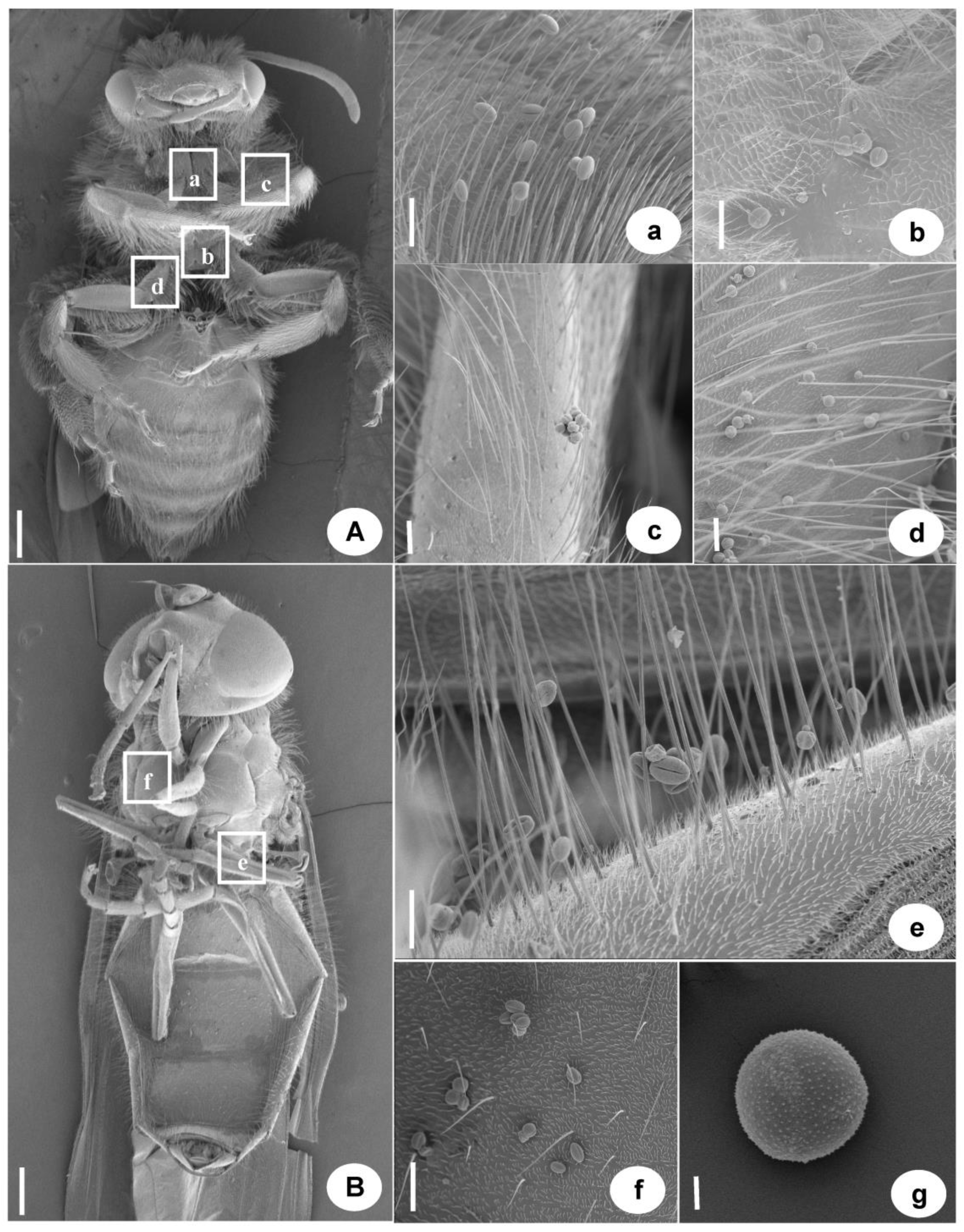
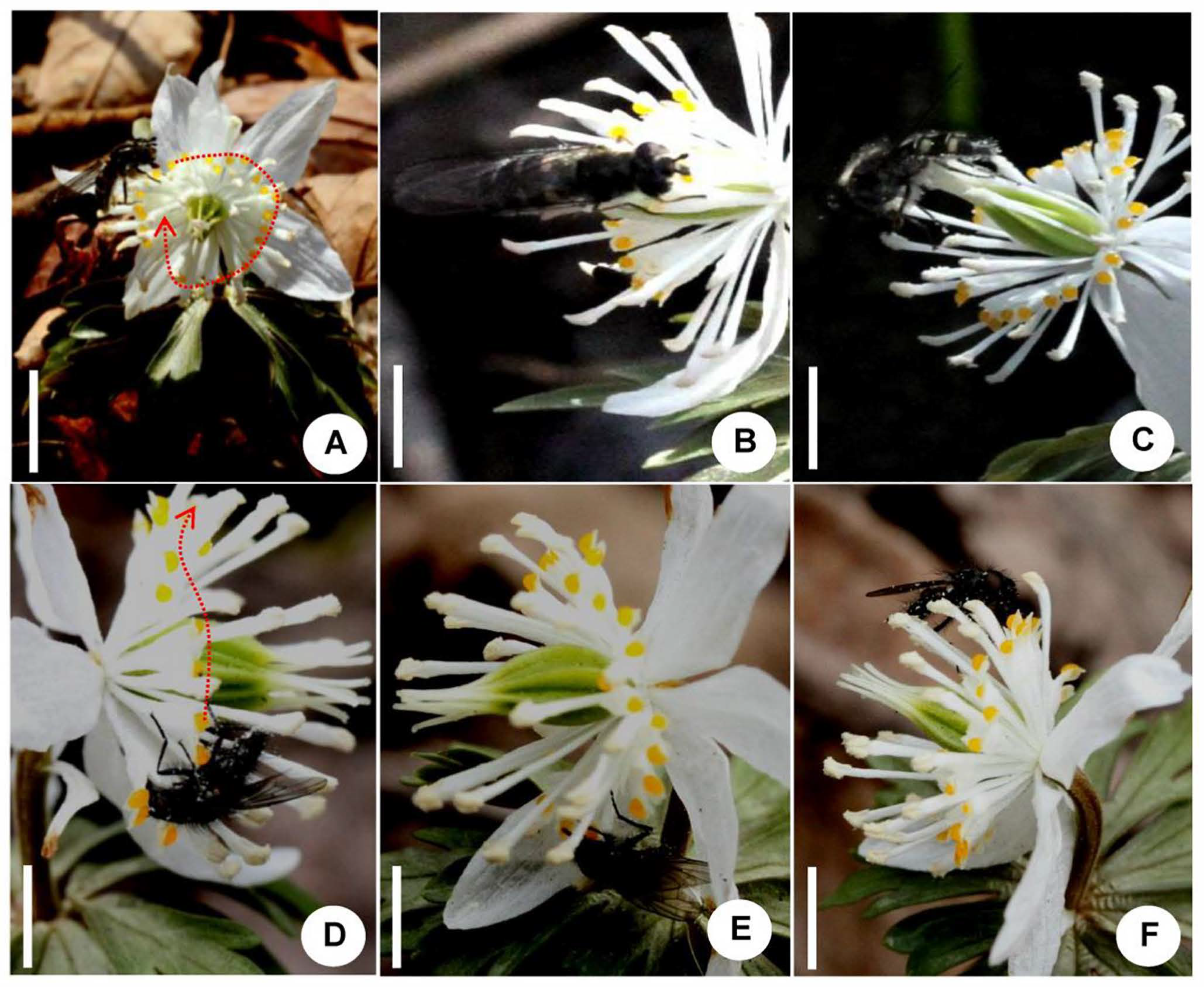
References
- Vezina, P.E.; Grandtne, M.M. Phenological observations of spring geophytes in Quebec. Ecology 1965, 46, 869–872. [Google Scholar] [CrossRef]
- Nishikawa, Y.; Kudo, G. Relationship between Flower Number and Reproductive Success of a Spring Ephemeral Herb, Anemone flaccida (Ranunculaceae). Plant Species Biol. 1995, 10, 111–118. [Google Scholar] [CrossRef]
- Lapointe, L. How phenology influences physiology in deciduous forest spring ephemerals. Physiol. Plant. 2001, 113, 151–157. [Google Scholar] [CrossRef] [PubMed]
- Barrett, S.C.H.; Helenurm, K. The reproductive biology of boreal forest herbs. I. Breeding systems and pollination. Can. J. Bot. 1987, 65, 2036–2046. [Google Scholar] [CrossRef]
- Miller, C.N.; Stuble, K.L. Warm Spring Days are Related to Shorter Durations of Reproductive Phenophases for Understory Forest Herbs. Ecol. Evol. 2024, 14, e70700. [Google Scholar] [CrossRef]
- Ashman, T.L.; Schoen, D.J. How long should flowers live? Nature 1994, 371, 788–791. [Google Scholar] [CrossRef]
- Hocking, B.; Sharplin, C.D. Flower Basking by Arctic Insects. Nature 1965, 206, 215. [Google Scholar] [CrossRef]
- Campbell, D.R.; Motten, A.F. The Mechanism of Competition for Pollination between Two Forest Herbs. Ecology 1985, 66, 554–563. [Google Scholar] [CrossRef]
- Alves-de-Lima, L.; Calixto, E.S.; Oliveira, M.L.d.; Novaes, L.R.; Almeida, E.A.B.; Torezan-Silingardi, H.M. Flowering Time Variation in Two Sympatric Tree Species Contributes to Avoid Competition for Pollinator Services. Plants 2023, 12, 3347. [Google Scholar] [CrossRef]
- Rathcke, B.; Lacey, E.P. Phenological patterns of terrestrial plants. Annu. Rev. Ecol. Syst. 1985, 16, 179–214. [Google Scholar] [CrossRef]
- Moyroud, E.; Glover, B.J. The physics of pollinator attraction. New Phytol. 2016, 216, 350–354. [Google Scholar] [CrossRef] [PubMed]
- Medel, R.; Botto-Mahan, C.; Kalin-Arroyo, M. Pollinator-mediated selection on the nectar guide phenotype in the Andean monkey flower, Mimulus luteus. Ecology 2003, 84, 1721–1732. [Google Scholar] [CrossRef]
- Goodale, E.; Kim, E.; Nabors, A.; Henrichon, S.; Nieh, J.C. The innate responses of bumble bees to flower patterns: Separating the nectar guide from the nectary changes bee movements and search time. Sci. Nat. 2014, 101, 523–526. [Google Scholar] [CrossRef]
- Dafni, A. Mimicry and deception in pollination. Ann. Rev. Ecol. Syst. 1984, 15, 259–278. [Google Scholar] [CrossRef]
- Indsto, J.O.; Weston, P.H.; Clements, M.A.; Dyer, A.G.; Batley, M.; Whelan, R.J. Pollination of Diuris maculata (Orchidaceae) by male Trichocolletes venustus bees. Aust. J. Bot. 2006, 54, 669–679. [Google Scholar] [CrossRef]
- Murúa, M.; Espíndola, A. Pollination syndromes in a specialized plant-pollinator interaction: Does floral morphology predict pollinators in Calceolaria? Plant Biol. 2015, 17, 551–557. [Google Scholar] [CrossRef]
- Ramírez-Aguirre, E.; Martén-Rodríguez, S.; Ornela, J.F. Floral Variation, Nectar Production, and Reproductive Success of Two Drymonia (Gesneriaceae) Species with Mixed Pollination Syndromes. Int. J. Plant Sci. 2016, 177, 469–480. [Google Scholar] [CrossRef]
- Moore, C.D.; Farman, D.I.; Särkinen, T.; Stevenson, P.C.; Vallejo-Marín, M. Floral scent changes in response to pollen removal are rarein buzz-pollinated Solanum. Planta 2024, 260, 15. [Google Scholar] [CrossRef]
- Zhang, J.L.; Hu, B.Z. Research advance in spring ephemerals. J. Northeast Agric. Univ. 2009, 40, 122–126. [Google Scholar] [CrossRef]
- Li, L.Q.; Tamura, M.; Wu, Z.Y.; Raven, P.H. (Eds.) Flora of China; Science Press: Beijing, China, 2001; pp. 117–118. [Google Scholar]
- Liao, H.; Fu, X.; Zhao, H.; Cheng, J.; Zhang, R.; Yao, X.; Duan, X.; Shan, H.; Kong, H. Author Correction: The morphology, molecular development and ecological function of pseudonectaries on Nigella damascena (Ranunculaceae) petals. Nat. Commun. 2020, 11, 2342. [Google Scholar] [CrossRef]
- Endress, P.; Matthews, M. Elaborate petals and staminodes in eudicots: Diversity, function, and evolution. Org. Divers. Evol. 2006, 6, 257–293. [Google Scholar] [CrossRef]
- Weber, A. Pollination of Nigella arvensis (Ranunculaceae) (film presentation). Syst. Evol. Ranunculiflorae 1995, 9, 325–326. [Google Scholar] [CrossRef]
- Rodriguez-Riano, T.; Dafni, A. A new procedure to asses pollen viability. Sex. Plant Reprod. 2000, 12, 241–244. [Google Scholar] [CrossRef]
- Dafni, A.; Maués, M.M. A rapid and simple procedure to determine stigma receptivity. Sex. Plant Reprod. 1998, 11, 177–180. [Google Scholar] [CrossRef]
- Harder, L.D. Functional differences of the proboscides of short- and long-tongued bees (Hymenoptera, Apoidea). Can. J. Zool. 1983, 61, 1580–1586. [Google Scholar] [CrossRef]
- Nepi, M. Nectary structure and ulstrastructure. In Nectaries and Nectar; Nicolson, S.W., Nepi, N., Pacini, E., Eds.; Springer: Dordrecht, The Netherlands, 2007; pp. 129–166. [Google Scholar] [CrossRef]
- Kudo, G.; Nishikawa, Y.; Kasagi, T.; Kosuge, S. Does seed production of spring ephemerals decrease when spring comes early? Ecol. Res. 2004, 19, 255–259. [Google Scholar] [CrossRef]
- Mamut, J.; Zhang, C.; Tan, D. Many Flowers but few Fruits: Pollinator and Pollen Limitation in the Early-Spring Flowering Cold Desert Perennial Iris tenuifolia. J. Plant Biol. 2024, 67, 333–344. [Google Scholar] [CrossRef]
- Kearns, C.A. North American Dipteran Pollinators: Assessing Their Value and Conservation Status. Conserv. Ecol. 2001, 5, 5. [Google Scholar] [CrossRef]
- Toivonen, M.; Karimaa, A.-E.; Herzon, I.; Kuussaari, M. Flies are important pollinators of mass-flowering caraway and respond to landscape and floral factors differently from honeybees. Agric. Ecosyst. Environ. 2022, 323, 107698. [Google Scholar] [CrossRef]
- Rader, R.; Edwards, W.; Westcott, D.A.; Cunningham, S.A.; Howlett, B.G. Diurnal effectiveness of pollination by bees and flies in agricultural Brassica rapa: Implications for ecosystem resilience. Basic Appl. Ecol. 2013, 14, 20–27. [Google Scholar] [CrossRef]
- Abdullah, S.; Ali, M.; Khan, F.Z.A.; Sajjad, A.; Qayyum, M.A.; Ahmad, N. Solitary Bees Are More Efficient Pollinators of Sponge Gourd than Giant honeybees and Syrphid Flies. Sociobiology 2024, 71, e10279. [Google Scholar] [CrossRef]
- Dafni, A. Pollination in Orchis and related genera: Evolution from reward to deception. In Orchid Biology: Reviews and Perspectives; Arditti, J., Ed.; Cornell University Press: Ithaca, NY, USA, 1987; pp. 79–104. [Google Scholar]
- Gan, S.-R.; Du, W.; Wang, X.-F. Functional Differentiation of Floral Color and Scent in Gall Midge Pollination: A Study of a Schisandraceae Plant. Plants 2022, 11, 974. [Google Scholar] [CrossRef] [PubMed]
- Dinkel, T.; Lunau, K. How drone flies (Eristalis tenax L., Syrphidae, Diptera) use floral guides to locate food sources. J. Insect Physiol. 2001, 47, 1111–1118. [Google Scholar] [CrossRef] [PubMed]
- Tremblay, R.L.; Ackerman, J.D.; Zimmerman, J.K.; Calvo, R.N. Variation in sexual reproduction in orchids and its evolutionary con-sequences: A spasmodic journey to diversification. Biol. J. Linn. Soc. 2005, 84, 1–54. [Google Scholar] [CrossRef]
- Jersáková, J.; Johnson, S.D.; Kindlmann, P. Mechanisms and evolution of deceptive pollination in orchids. Biol. Rev. 2006, 81, 219–235. [Google Scholar] [CrossRef]
- Lunau, K.; Ren, Z.-X.; Fan, X.-Q.; Trunschke, J.; Pyke, G.H.; Wang, H. Nectar mimicry: A new phenomenon. Sci. Rep. 2020, 10, 7039. [Google Scholar] [CrossRef]
- Lunau, K.; De Camargo, M.G.G.; Brito, V.L.G. Pollen, anther, stamen, and androecium mimicry. Plant Biol. 2024, 26, 349–368. [Google Scholar] [CrossRef]
- Lunau, K.; Unseld, K.; Wolter, F. Visual detection of diminutive floral guides in the bumblebee Bombus terrestris and in the honeybee Apis mellifera. J. Comp. Physiol. A 2009, 195, 1121–1130. [Google Scholar] [CrossRef]
- Polidori, C.; Ferrari, A.; Ronchetti, F. Biology and Behaviour of European Wild Bees. In Hidden and Wild: An Integrated Study of European Wild Bees; Springer Nature: Cham, Switzerland, 2025; pp. 49–118. [Google Scholar] [CrossRef]
- Manetas, Y.; Petropoulou, Y. Nectar Amount, Pollinator Visit Duration and Pollination Success in the Mediterranean Shrub Cistus creticus. Ann. Bot. 2000, 86, 815–820. [Google Scholar] [CrossRef]
- Varassin, I.G.; Trigo, J.R.; Sazima, M. The role of nectar production, flower pigments and odour in the pollination of four species of Passiflora (Passifloraceae) in south-eastern Brazil. Biol. J. Linn. Soc. 2001, 136, 139–152. [Google Scholar] [CrossRef]
- Wang, W.; Lu, A.-M.; Ren, Y.; Endress, M.E.; Chen, Z.-D. Phylogeny and classification of Ranunculales: Evidence from four molecular loci and morphological data. Plant Ecol. Evol. Syst. 2009, 11, 81–110. [Google Scholar] [CrossRef]
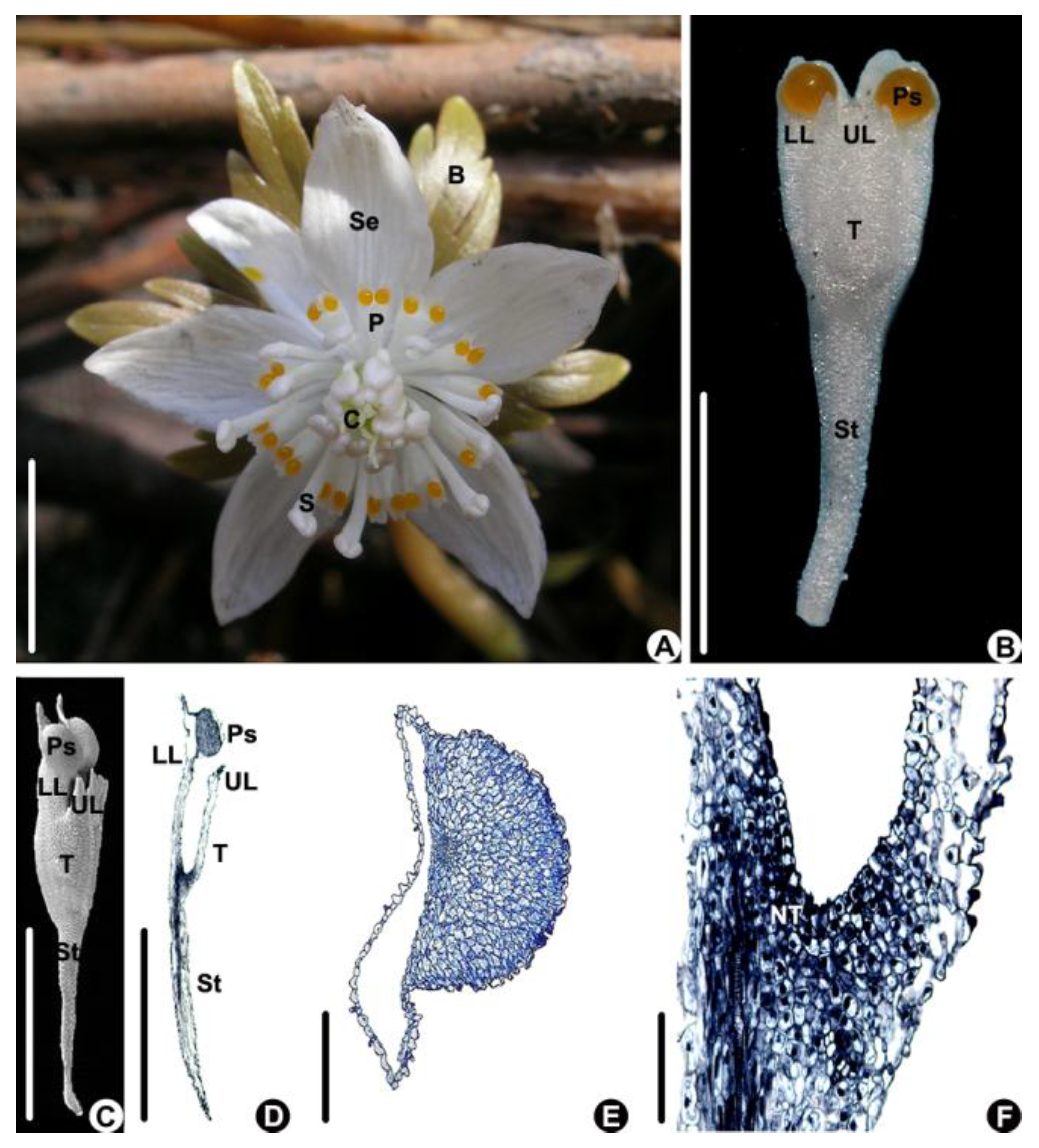
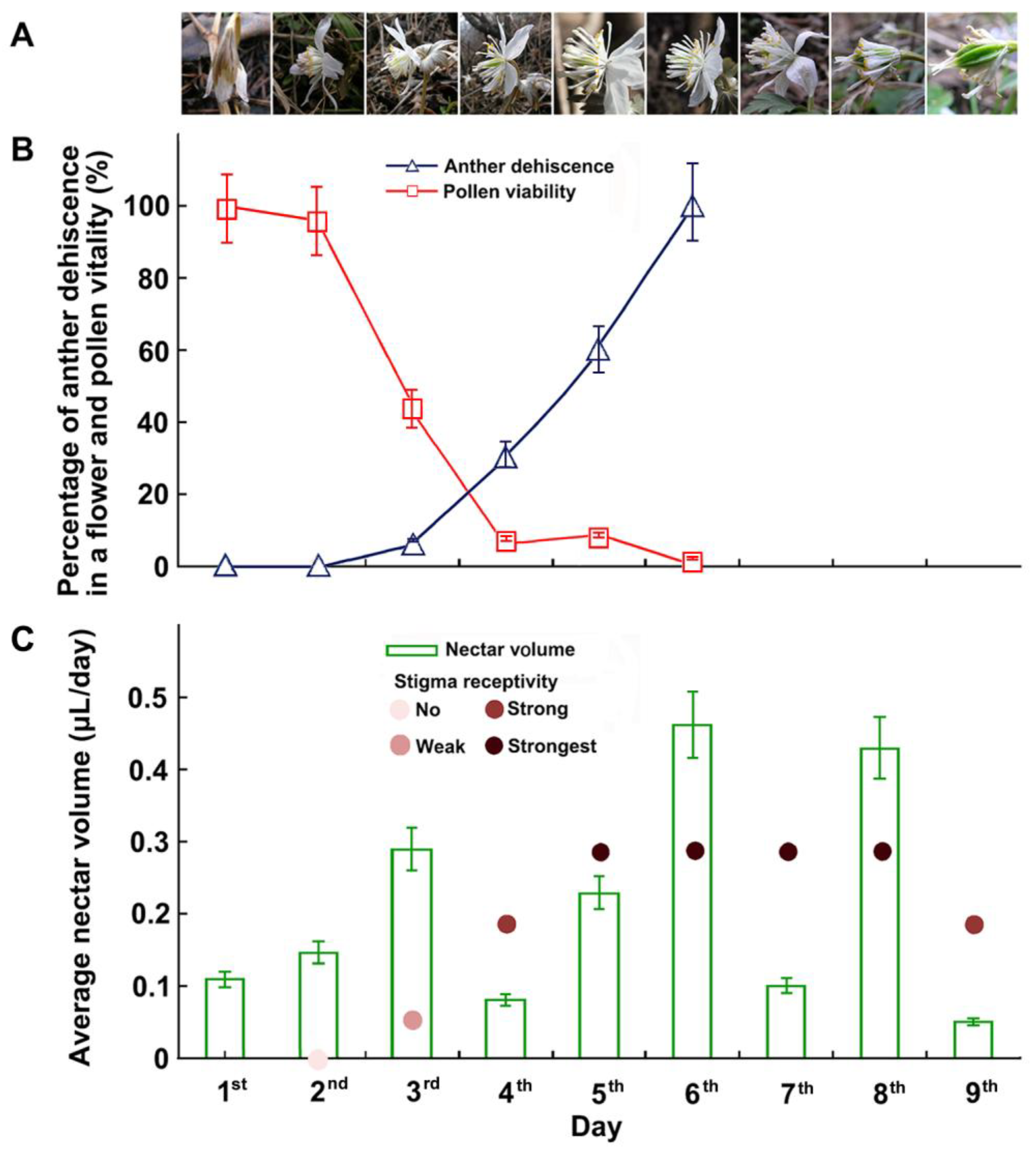

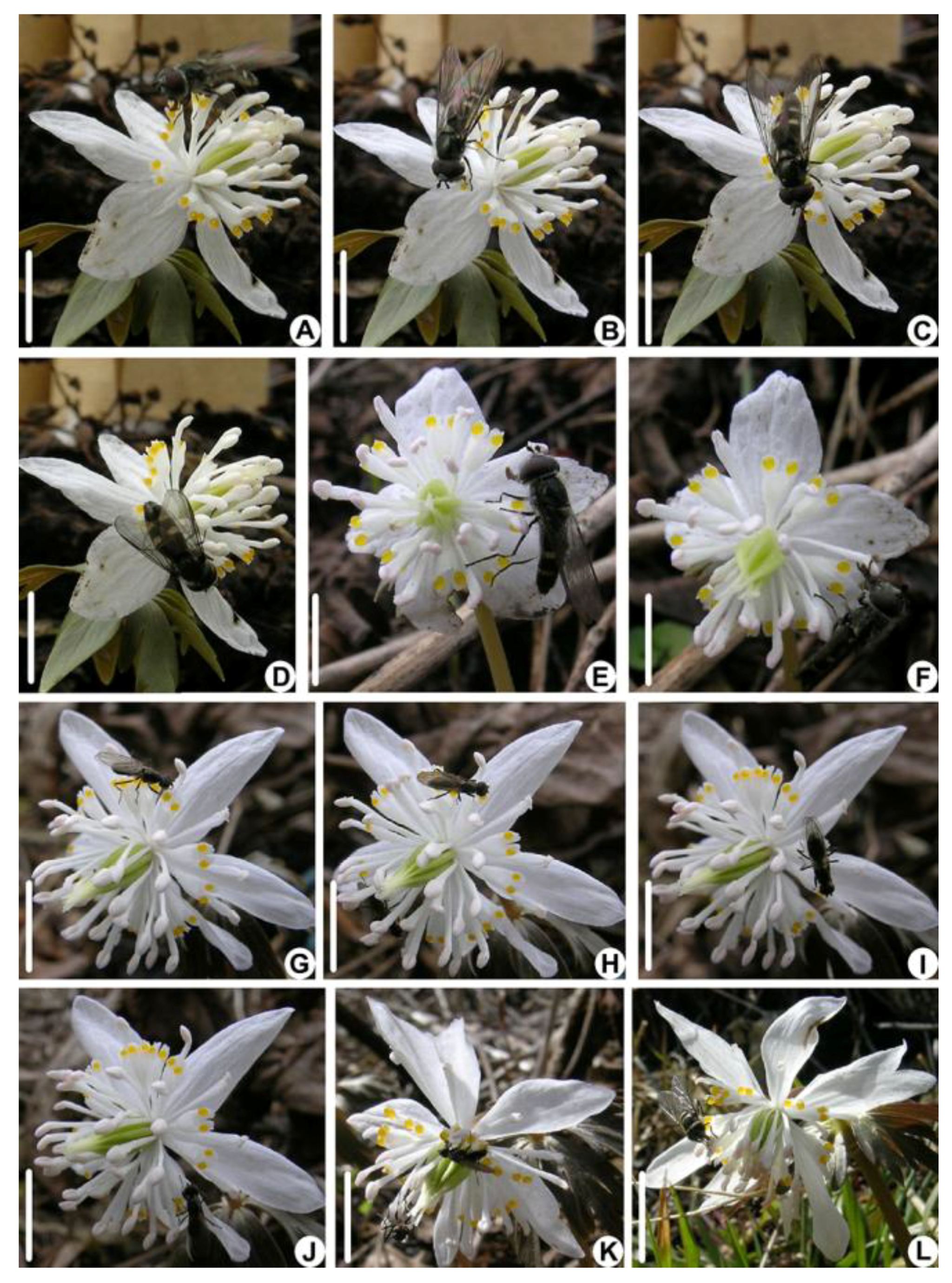
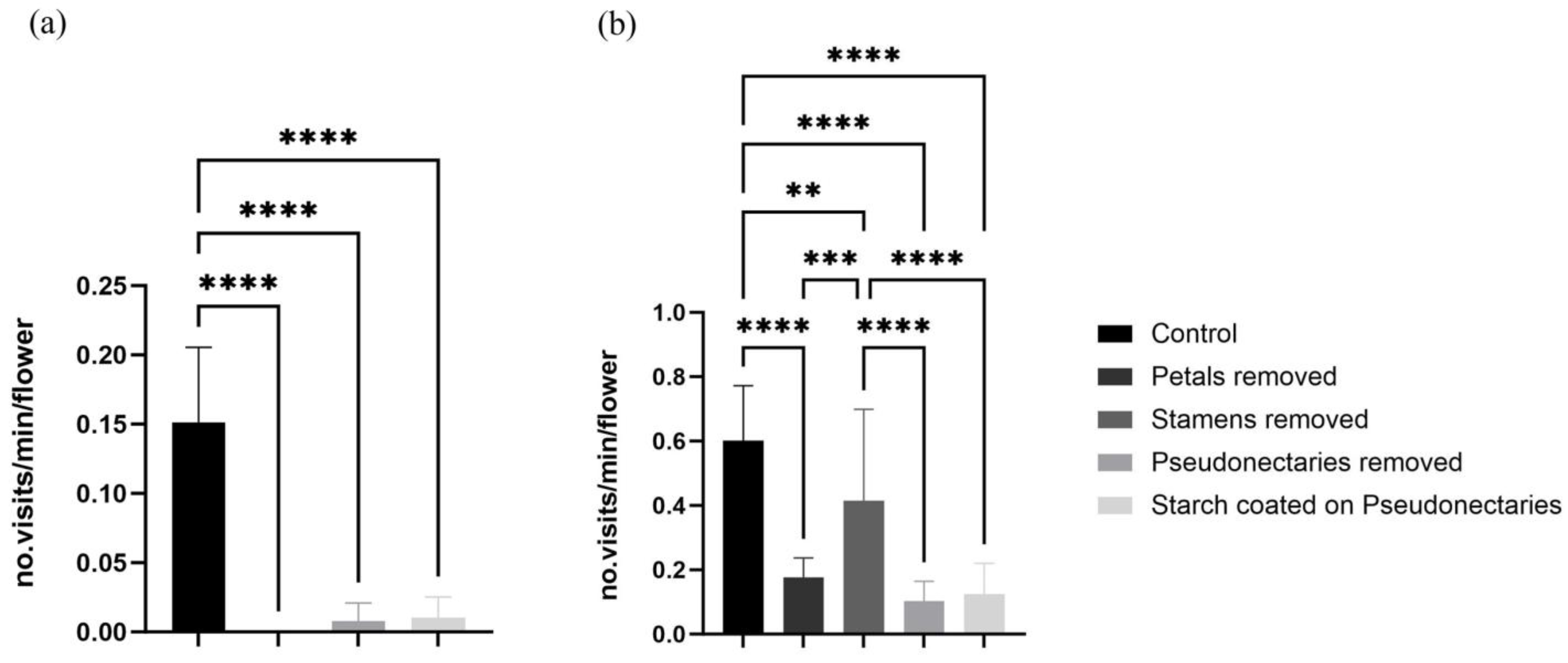
| Visitor | Length of Proboscis (mm) | Foraging | Pollen-Carrying Position and Amount | Visiting Frequency (Times /Flower/min) (Mean ± s. e., Range) | Average Time Spent on Stamens (Second) | Average Time Spent on Petals (Second) | |||
|---|---|---|---|---|---|---|---|---|---|
| Head | Thorax | Abdomen | Leg | ||||||
| Diptera | |||||||||
| Hoverfly (Platycheirus scutatus) | 0.53 ± 0.042 | Pollen | + | - | ++ | + | 0.166 ± 0.02 (0.08–0.24) | 23.10 ± 8.74 | 54.45 ± 15.82 |
| Fly (Milesiinae sp.) | 0.46 ± 0.021 | Pollen | - | - | - | +++ | 0.11 ± 0.02 (0.47–0.25) | 26.06 ± 9.45 | 42.43 ± 19.51 |
| Fruit fly (Drosophila sp.) | - | Pollen | - | - | - | - | 0.07 ± 0.01 (0.03–0.12) | 23.03 ± 7.35 | 39.33 ± 18.93 |
| Hymenoptera | |||||||||
| Asian honey bee (Apis cerana cerana) | 4.03 ± 0.25 | Nectar | - | +++ | +++ | +++ | 0.10 ± 0.02 (0.06–0.16) | 0 | 30.35 ± 19.37 |
| Melittid bee (Melitta taishanensis) | 6.32 ± 0.26 | Nectar | + | + | +++ | ++ | 0.08 ± 0.01 (0.05–0.11) | 0 | 58.26 ± 39.56 |
Disclaimer/Publisher’s Note: The statements, opinions and data contained in all publications are solely those of the individual author(s) and contributor(s) and not of MDPI and/or the editor(s). MDPI and/or the editor(s) disclaim responsibility for any injury to people or property resulting from any ideas, methods, instructions or products referred to in the content. |
© 2025 by the authors. Licensee MDPI, Basel, Switzerland. This article is an open access article distributed under the terms and conditions of the Creative Commons Attribution (CC BY) license (https://creativecommons.org/licenses/by/4.0/).
Share and Cite
Zhang, J.; Sui, J.; Wang, L.; Tian, X.; Zhang, X.; Xu, J.; Gao, T. Pollination Strategies of Eranthis stellata (Ranunculaceae), a Spring Ephemeral with Elaborate Petals. Biology 2025, 14, 804. https://doi.org/10.3390/biology14070804
Zhang J, Sui J, Wang L, Tian X, Zhang X, Xu J, Gao T. Pollination Strategies of Eranthis stellata (Ranunculaceae), a Spring Ephemeral with Elaborate Petals. Biology. 2025; 14(7):804. https://doi.org/10.3390/biology14070804
Chicago/Turabian StyleZhang, Jiudong, Jie Sui, Lin Wang, Xianhua Tian, Xiaohui Zhang, Jing Xu, and Tianpeng Gao. 2025. "Pollination Strategies of Eranthis stellata (Ranunculaceae), a Spring Ephemeral with Elaborate Petals" Biology 14, no. 7: 804. https://doi.org/10.3390/biology14070804
APA StyleZhang, J., Sui, J., Wang, L., Tian, X., Zhang, X., Xu, J., & Gao, T. (2025). Pollination Strategies of Eranthis stellata (Ranunculaceae), a Spring Ephemeral with Elaborate Petals. Biology, 14(7), 804. https://doi.org/10.3390/biology14070804







